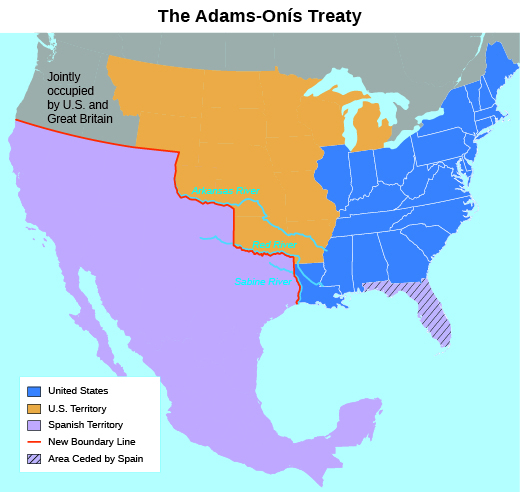| << Chapter < Page | Chapter >> Page > |
Spanish Florida had presented difficulties for its neighbors since the settlement of the original North American colonies, first for England and then for the United States. By 1819, American settlers no longer feared attack by Spanish troops garrisoned in Florida, but hostile tribes like the Creek and Seminole raided Georgia and then retreated to the relative safety of the Florida wilderness. These tribes also sheltered runaway slaves, often intermarrying with them and making them members of their tribes. Sparsely populated by Spanish colonists and far from both Mexico City and Madrid, the frontier in Florida proved next to impossible for the Spanish government to control.
In March 1818, General Andrew Jackson, frustrated by his inability to punish Creek and Seminole raiders, pursued them across the international border into Spanish Florida. Under Jackson’s command, U.S. troops defeated the Creek and Seminole, occupied several Florida settlements, and executed two British citizens accused of acting against the United States. Outraged by the U.S. invasion of its territory, the Spanish government demanded that Jackson and his troops withdraw. In agreeing to the withdrawal, however, U.S. Secretary of State John Quincy Adams also offered to purchase the colony. Realizing that conflict between the United States and the Creeks and Seminoles would continue, Spain opted to cede the Spanish colony to its northern neighbor. The Adams-Onís Treaty, named for Adams and the Spanish ambassador, Luís de Onís, made the cession of Florida official while also setting the boundary between the United States and Mexico at the Sabine River ( [link] ). In exchange, Adams gave up U.S. claims to lands west of the Sabine and forgave Spain’s $5 million debt to the United States.

The Adams-Onís Treaty upset many American expansionists, who criticized Adams for not laying claim to all of Texas, which they believed had been included in the Louisiana Purchase. In the summer of 1819, James Long, a planter from Natchez, Mississippi, became a filibuster , or a private, unauthorized military adventurer, when he led three hundred men on an expedition across the Sabine River to take control of Texas. Long’s men succeeded in capturing Nacogdoches, writing a Declaration of Independence (see below), and setting up a republican government. Spanish troops drove them out a month later. Returning in 1820 with a much smaller force, Long was arrested by the Spanish authorities, imprisoned, and killed. Long was but one of many nineteenth-century American filibusters who aimed at seizing territory in the Caribbean and Central America.
The Long Expedition’s short-lived Republic of Texas was announced with the drafting of a Declaration of Independence in 1819. The declaration named settlers’ grievances against the limits put on expansion by the Adams-Onís treaty and expressed their fears of Spain:
The citizens of Texas have long indulged the hope, that in the adjustment of the boundaries of the Spanish possessions in America, and of the territories of the United States, that they should be included within the limits of the latter. The claims of the United States, long and strenuously urged, encouraged the hope. The recent [Adams-Onís] treaty between Spain and the United States of America has dissipated an illusion too long fondly cherished, and has roused the citizens of Texas . . . They have seen themselves . . . literally abandoned to the dominion of the crown of Spain and left a prey . . . to all those exactions which Spanish rapacity is fertile in devising. The citizens of Texas would have proved themselves unworthy of the age . . . unworthy of their ancestry, of the kindred of the republics of the American continent, could they have hesitated in this emergency . . . Spurning the fetters of colonial vassalage, disdaining to submit to the most atrocious despotism that ever disgraced the annals of Europe, they have resolved under the blessing of God to be free.
How did the filibusters view Spain? What do their actions say about the nature of American society and of U.S. expansion?
In 1803, Thomas Jefferson appointed Meriwether Lewis to organize an expedition into the Louisiana Territory to explore and map the area but also to find an all-water route from the Missouri River to the Pacific Coast. The Louisiana Purchase and the journey of Lewis and Clark’s Corps of Discovery captured the imagination of many, who dedicated themselves to the economic exploitation of the western lands and the expansion of American influence and power. In the South, the Adams-Onís treaty legally secured Florida for the United States, though it did nothing to end the resistance of the Seminoles against American expansionists. At the same time, the treaty frustrated those Americans who considered Texas a part of the Louisiana Purchase. Taking matters into their own hands, some American settlers tried to take Texas by force.

Notification Switch
Would you like to follow the 'U.s. history' conversation and receive update notifications?